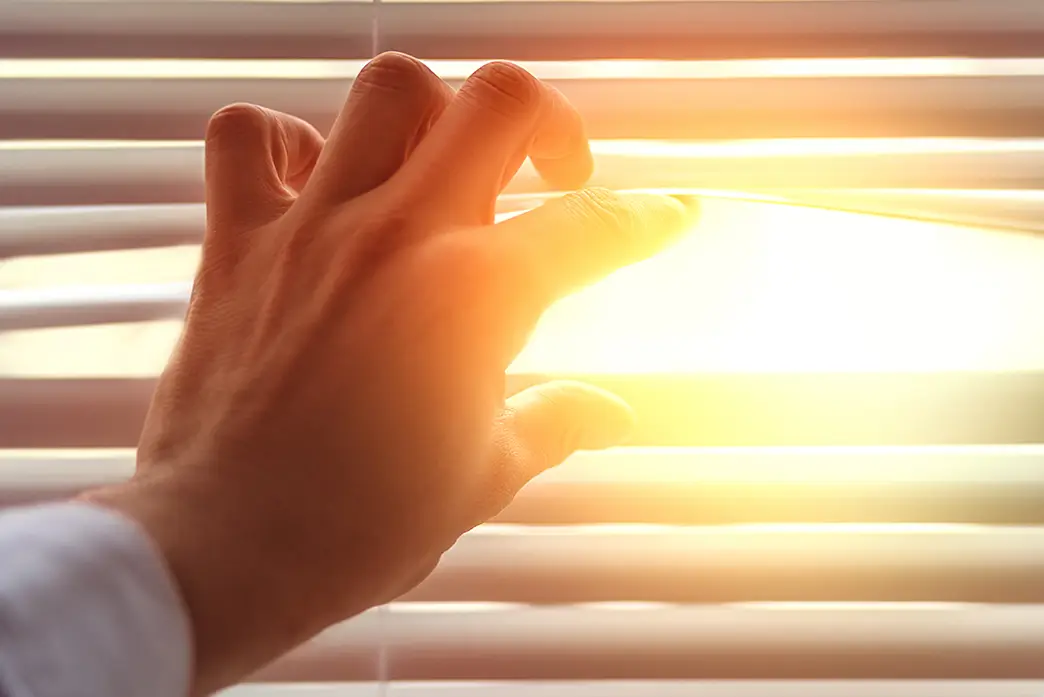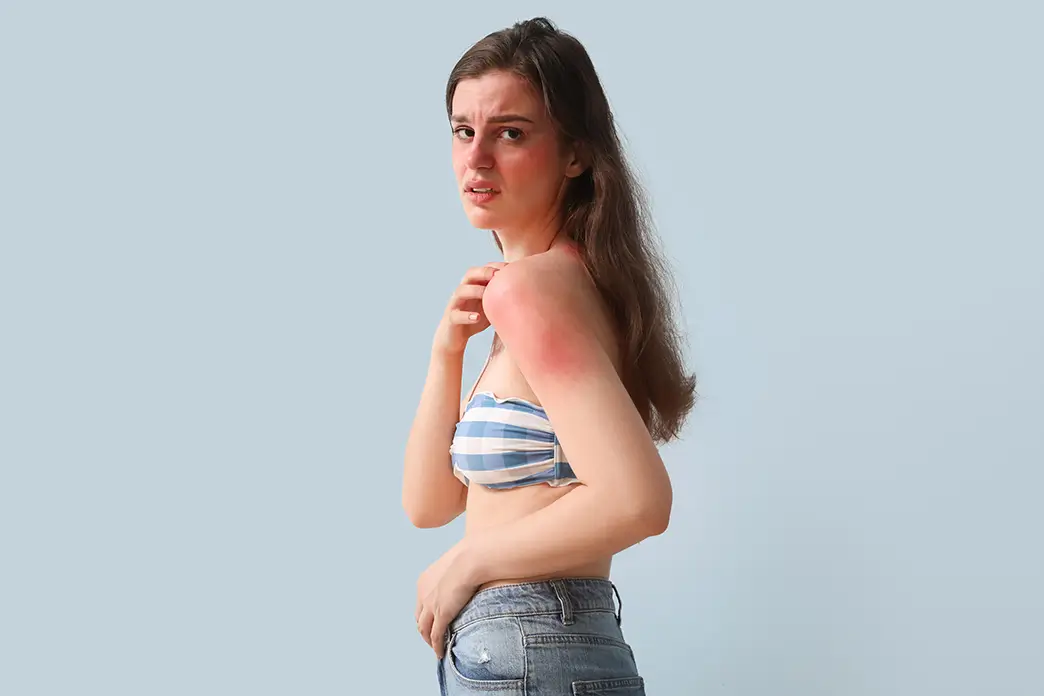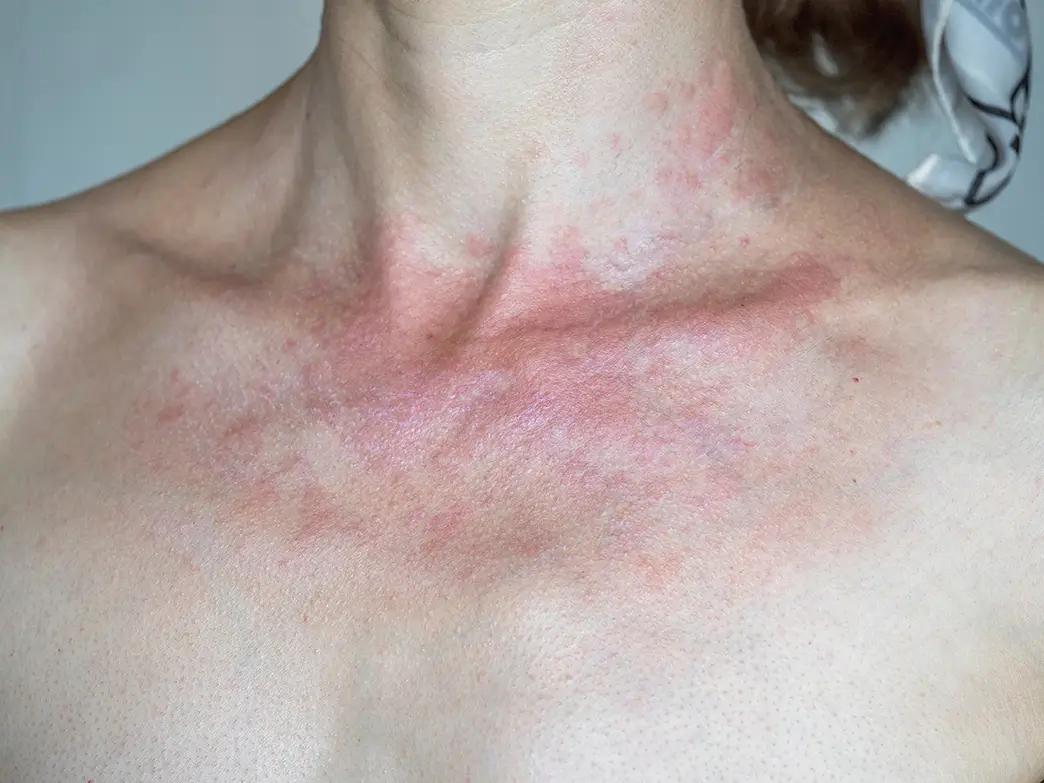
Sun Allergy – Polymorphic Light Eruption
Some people cannot tolerate sunlight – their skin shows symptoms like itchy rash, welts, or blisters sooner or later when in contact with sunlight. This is often referred to as a sun allergy. However, there is no allergy behind these symptoms. In most cases, the symptoms are caused by the skin disease polymorphous light eruption (PLE). This condition usually appears for the first time each year at the beginning of spring, when the sun shines longer and its rays become stronger.
This article deals with sun allergy, related conditions such as phototoxic reactions, possible causes, and protection and treatment options. With a click of the mouse, you can select the section you want to read and jump directly to it.
Contents
Contents

Which symptoms are typical for a "sun allergy"?
For most affected individuals, sun allergy symptoms first appear in spring on skin areas that have not been exposed to sunlight for a long time. Therefore, the effects are mainly seen on the arms and legs, as well as on the trunk or décolleté. In individuals with more pronounced polymorphous light eruption, the increasing sunlight can also trigger reactions on the face. Only in very severe cases of PLE do sufferers experience skin reactions in winter. In general, this condition occurs more frequently in people with fair skin. It is also worth noting that the symptoms usually appear one to two days after the skin’s initial contact with sunlight.
Typical symptoms of PLE include skin redness, rash, and small blisters. The affected areas often cause intense itching. In severe cases, pustules and bleeding areas can develop – scratching the itchy areas should be avoided at all costs. If the affected skin areas feel noticeably warmer, this also indicates a sun allergy. If red blisters form, resembling those caused by nettles, it could be solar urticaria, a rare form of sun allergy that can also affect the circulatory system.
If circulatory problems such as dizziness, nausea, or weakness occur along with the symptoms, medical help should be sought immediately. Although sun allergy is more of an annoyance than a danger, severe cases are rare. However, while in the sun, there are other dangers like sunburn or sunstroke due to overheating. If sun allergy symptoms occur along with a sunburn, they might be overlooked. A very severe sunburn often comes with body overheating, which can lead to heat collapse. Fortunately, polymorphous light eruption does not cause such problems.

What causes polymorphous light eruption?
Human skin has a mechanism to react to increasing or more intense exposure to UV light. It produces higher amounts of melanin – a pigment that darkens the skin and blocks UV light. Melanin is why the skin tans after sunbathing. In polymorphous light eruption, this process seems to be disturbed. It is not surprising that fair-skinned people are particularly prone to sun allergy. Their skin stores less melanin than darker skin types and is also more sensitive to sunburn. It is a known phenomenon that many pale people find it difficult to tan in summer.
Exactly how PLE develops is not yet understood – alongside the melanin connection, there are several other theories. It is suggested that UV light stimulates the production of free radicals in the skin cells of "sun allergy sufferers," leading to an overreaction of the skin’s immune system. Another theory suggests that under sunlight, allergens might form, triggering PLE like a classic allergy. None of these theories have been proven so far.
What is Mallorca Acne?
The so-called “Mallorca acne” (acne aestivalis) was a skin disease that was particularly common among holidaymakers in sunny travel destinations in the 1980s. Mallorca, which was becoming the favorite island of Germans at that time, saw many cases – hence the name. The symptoms resemble a sun allergy and can even lead to acne-like pustules. Today, this condition is rare because it turned out that acne aestivalis only occurred in connection with certain sunscreens and interaction with UV radiation. The responsible ingredients were identified and are no longer present in modern products. Whether Mallorca acne was an immune response or “just” a skin irritation remains unclear.
What are phototoxic and photoallergic reactions?
Photoreactions can occur in connection with various substances. For example, some perfumes contain ingredients that change upon contact with sunlight, developing toxic or skin-damaging properties. Additionally, there are several plant species known to be "phototoxic" and cause symptoms similar to a sun allergy.
Phototoxic reactions occur through "poisoning" of the skin cells by biological or chemical substances in connection with UV exposure. Various medications can increase the skin’s sensitivity to light. Both topically applied drugs (creams, ointments, etc.) and oral medications (some anti-rheumatic drugs, diuretics, etc.) can have these properties. If known, this information can be found under the side effects of the medication. Anyone taking such medication must avoid UV light, as it can quickly lead to irritation or even skin damage. The risk of getting sunburned increases significantly.

Phototoxic reactions are often also triggered by plants whose sap contains phototoxic furocoumarins. These substances are found, among other things, in the peel of citrus fruits. Another prominent example is St. John's Wort, which contains high concentrations of hypericin. As an active ingredient, hypericin is used in antidepressants, for example. However, it leads to increased UV sensitivity of the skin because phototoxic substances only become toxic when they come into contact with UV light.
Gardeners and landscapers come into contact with phototoxic plants particularly frequently. However, sometimes symptoms also appear after a walk in shorts through flowering meadows. The resulting skin problems are colloquially referred to as “meadow grass dermatitis” because they are triggered by various garden or wild plants. Known phototoxic plants include bishop's weed, spotted hemlock, herbs like anise, dill, fennel, or coriander, and umbellifers like giant hogweed.
Photoallergic reactions are triggered by the interaction of UV light with chemical or other substances. For example, some medications, perfumes, or cosmetics can provoke immune system overreactions in affected people. Mallorca acne could have been a photoallergic reaction.

How to protect yourself if you have a sun allergy?
The easiest way to prevent a sun allergy is to avoid sunlight. This does not mean that you cannot leave the house at all if you have PLD. As long as you do not suffer from a severe form, you can effectively protect yourself with long clothing and sun hats to expose as little skin as possible to the sun. Combine your clothing choice with a high-quality sunscreen. It is recommended to choose a cream with the highest possible sun protection factor and a combination of UVA and UVB filters.
If you are sensitive to heat and have sensitive skin, you should gradually get used to the sun and heat. Initially, expose yourself to the sun for only a few minutes a day. In many cases, the symptoms of a sun allergy decrease once the skin gets used to UV light. The strongest sunlight is at midday – prefer to go outside in the morning or evening. Occasionally, it is heard that dietary supplements with antioxidants like vitamin E or beta-carotene make the skin less sensitive to UV light. However, this is a theory – the effectiveness against sun allergy is not scientifically proven.
If you suffer from a severe form of polymorphous light eruption, you should definitely seek medical help.
Can PLE be cured?
Polymorphous light eruption can be treated – it cannot be completely cured. Nevertheless, even in many severe cases that prevent natural acclimatization to sunlight, a type of desensitization can be carried out under medical supervision. Contact a dermatology practice near you. A targeted light therapy can be performed there to very gently and slowly adjust the skin to UV radiation. If a severe sun allergy is known, this treatment can already be started in the winter months to prepare the skin for spring and summer.
Itching, rashes, and blister formations can be treated with cooling and soothing ointments. In severe cases, cortisone-containing medications can provide relief. However, the treatment and management of sun allergy should aim to prevent an acute outbreak from occurring in the first place.



